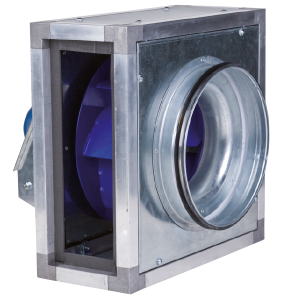What is a fan coil called?
The fan coil is one of the most popular devices for air conditioning, which, like any other air conditioning device, takes the incoming air, changes it and returns it to the environment. The range of functions of the fan coil in air circulation and air temperature regulation is defined. This device, as a heat exchanger, takes the incoming air, simply changes its temperature, and then returns it to the environment with a new temperature. This function is the same in all types of fan coils, even duct fan coils. This operation takes place in the fan coils by the coils, fan, motor, inlet and outlet pipes of hot and cold water into the coil and air filter. In this way, hot or cold water enters the pipes through a package, boiler or chiller to enter the coils. Copper coils or finned tubes bent in several rows and placed next to each other provide an environment for heat exchange. In the cold season, hot water enters the pipes and then the coils, heating the copper coils. The rotation of the fan causes the air to be in contact with these coils, to exchange heat, and eventually to reach a higher temperature. This hot air comes out of the fan coil and is directed to the desired room through the vents. In hot seasons, the same thing happens in reverse. Coldwater enters the coils, hot air comes in contact with the coils and the temperature decreases.
What is a ducted fan coil?
Now that we are familiar with the fan coil and how it works, we turn to the Ducted fan coil, one of the types of ceiling fan coils. Duct fan coils are similar to other fan coils such as overhead ceiling fan coils or duct fan coils. Therefore, when the name of the duct is mentioned, it means a fan coil that is installed in the roof and in the form of a work. But what do these two features mean?
The first feature that goes back to the installation location of the fan coil means that the duct fan coil is installed in the front of the ceiling, so it does not take up a volume of useful space in the room. The second feature also means that it is placed inside the roof and no part of it is outside except the vent. This saves space on the fan coil again.
Due to the installation of the duct fan coil, which is in front of the roof and in fact on the wall at the closest point to the ceiling, the wind blows from the opposite direction. But in any case, the duct fan coil is available in two types, horizontal and vertical.
In general, it can be said that duct fan coils are air conditioners that are designed to be completely hidden and out of sight, but can provide heat and cold to the environment. They can be considered as versatile yet quiet interiors, which are ideal for spaces such as hotels. Each passenger and guest or in other words each room can have its own temperature. It is also possible to control them more precisely and apply remote control to the duct fan coils. For example, these fan coils can be activated with the guest entry card or turned off when the hotel room windows open.

Positive features and benefits of duct
- In the previous section, we talked about the features related to the installation of fan coils. This feature leaves users free to use the duct fan coil. This means that any room and space with any area and ceiling height can use this fan coil. Therefore, any space with any user, including residential, commercial, office, educational and recreational can use the fan duct for their air conditioning.
- Another positive feature of Duct Fan Coil is the ability to separate the air in each room from the other.
- The use of special filters to reduce noise and noise pollution is another positive feature of duct fan coils.
- Economical and cost-effective purchase of the Kuwait Duct fan along with its long useful life are other advantages.
What are the disadvantages of duct fan coils?
Disadvantages of the fan coil include the inability to regulate humidity and also not freshen the incoming air. The air that enters the duct fan coil is the air consumed inside the room. This air does not mix with other fresh air. This means that the fan coil only sucks in the air inside the room and not fresh air from another place. The room air in the duct fan coil reaches the temperature setting, passes through the filters and enters the room again with the same quality of used air. In this way, this stationary air is used again and again.
Similarities and differences between duct fan coils and other fan coils
The ducted fan coils work like any other fan coil, and this is the same for all fan coils. On the other hand, the duct fan coil is similar to the fan coil in terms of location and installation, which is installed inside the roof and hidden inside. Of course, it should be said that the installation steps should be done according to the manual or fan installation guide, but these two fan coils also have differences. The differences between the ducts and their shortcomings include the shape of their outlet valve. The defective fan coil outlet valve is a control panel, while the duct fan coil valve is a simple valve.
Another difference between a duct fan coil and a fault is that the fan coil has a fault for draining the water collected in the pump fan coil. This pump directs water directly to the place where it should be drained. But the duct does not have a drain pump for itself and must use drainpipes to drain the water collected by distillation on the pipes.

 English
English  فارسی
فارسی 



